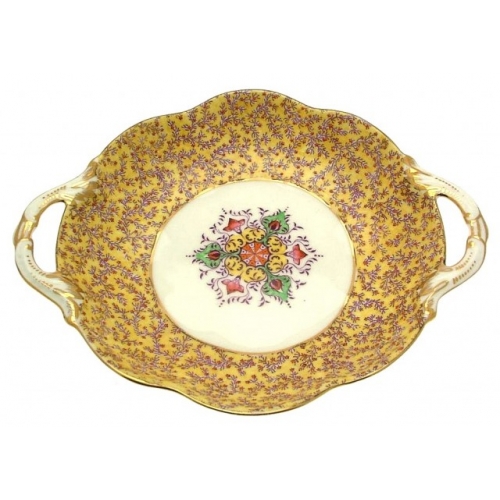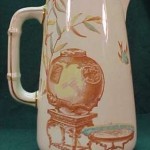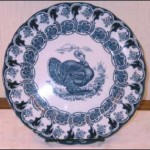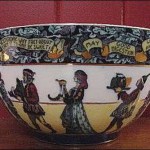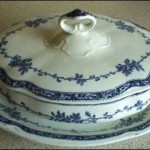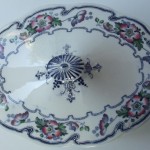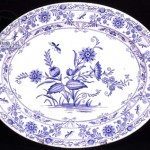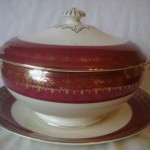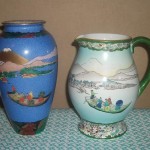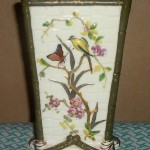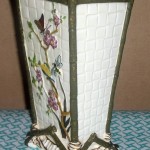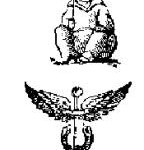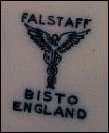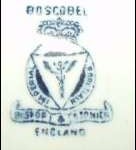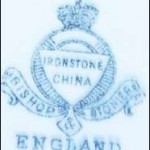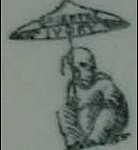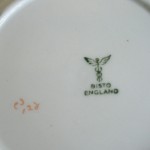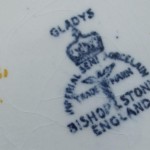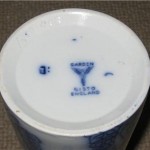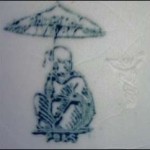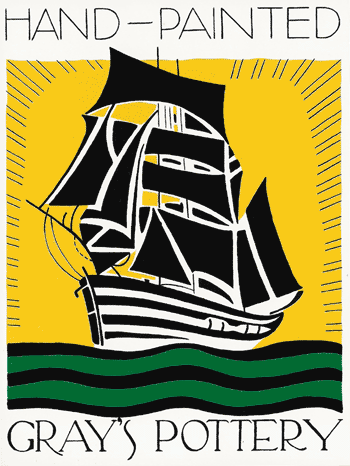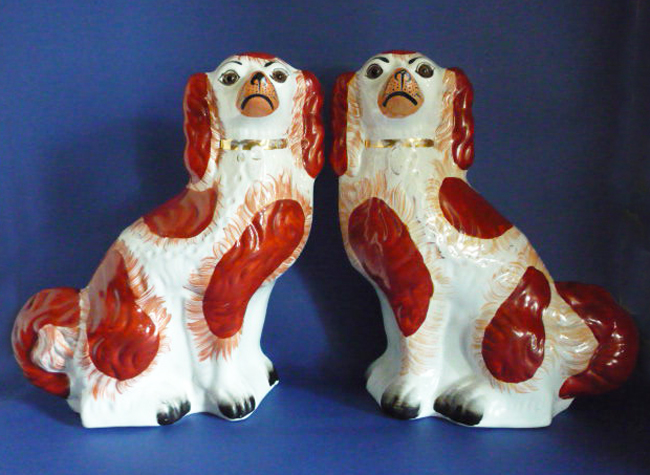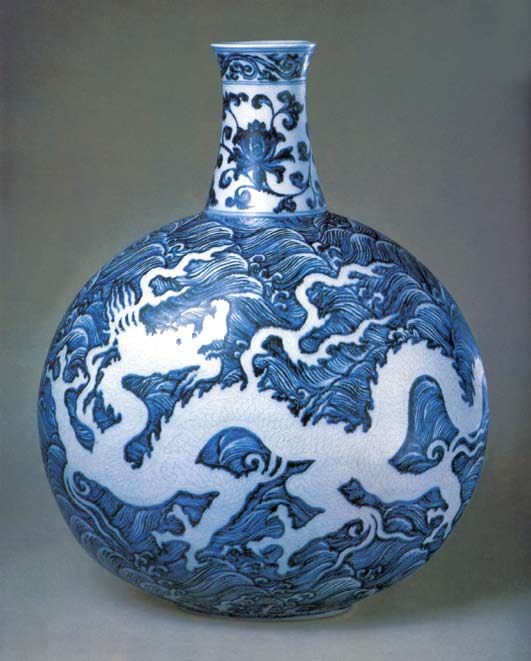Manufacturers of porcelain and earthenwares at Hanley.
c. 1891-1939
China and Earthenware manufacturer at the Stafford Street Works and the Church Works, Hanley, Stoke-on-Trent.
Formerly: Powell, Bishop & Stonier [1878-1891]
- Stafford Street, Hanley
- 1893 trade journal entry on Bishop & Stonier
- PLATE MEASURES 10 3/8 INCHES IN DIAMETER PATTERN NAME, “FLORENCE”, THEN THE WAND OF CADUCEUS, THEN “BISTO”, THEN “ENGLAND”. AND THE IMPRESSED WAND OF CADUCEUS
- Bishop & Stonier began producing Aztec Ware in the 1920’s, This large fruit bowl or punch bowl perhaps measures 10 1/4 inches in diameter, and just over 5 inches in height. It features a Shakespearian repeating pattern of attendants and verse that reads: “May good digestion wait on appetite and health on both better be merry with the fruitful grape than sadder after none, or bitter, fruit. Unborn to-morrow and dead.” The bowl has a bluish/black transfer printed border with hand-painted gold lustre and green leafy details. The characters are mostly hand-painted with a bright, vibrant lustre-type paint.
- Boscobel Pattern Tureen set marked Bishop And Stonier England / Imperial Semi Porcelain.
- An Aesthetic P.B&S vase (1880s)
- An Aesthetic P.B&S vase (1880s)
Bishop and Stonier Partnership
KEY DATES
1851 – 1866 Livesley Powell & Co. Old Hall Lane and Miles Bank, Hanley
1867 – 1878 Powell & Bishop Parliament Row and Stafford Street Works, Hanley
1878 – 1891 Powell, Bishop & Stonier Stafford Street Works, Hanley
1891 – 1933 Bishop & Stonier various addresses, Hanley
1933 – 1939 George Jones & Sons bought the company and continued use of the Bisto trade mark
DESCRIPTION
Livesley Powell & Co. was formed in 1845 by William Livesley, Edwin Powell and Frederick Bishop. The Livesley family were potters in Hanley; Edwin Powell was a potter who had been apprenticed at Dimmocks of Hanley; and Frederick Bishop was a lawyer providing financial support to the venture.
In 1866 William Livesley retired and the partnership became known as Powell and Bishop.
In 1878 Powell and Bishop were joined by John Stonier who was a china and glass merchant in Liverpool, employing around 400 people. One of his company’s specialities was fitting out liners of the day, such as Brunel’s Great Britain and the ill-fated Titanic.
Livesley Powell produced a variety of bodies including china, parian, and ironstone china and used transfer printing (sometimes in lilac), moulded, painted and lustre decoration. They patented a process of printing in gold and colours which produced a dead gold background. Much of their production was exported, with over one million different items sent to New York alone in 1851. They are reported to have exhibited at the 1851 Great Exhibition. Marks on their wares incorporate the name of the firm or the initials L.P. & Co.
In 1876, Powell and Bishop exhibited at the Philadelphia Exhibition.
In 1880, Powell, Bishop and Stonier registered a new trademark to accompany their ivory or cream coloured earthenware. This shows a seated Chinaman under a sunshade or umbrella containing the words ORIENTAL IVORY – their name for the earthenware body. This oriental ivory body and their green bodied porcelain were ideal vehicles for Japanese inspired designs which were popular in the Victorian period. These often featured asymmetrical floral and bird designs.
In 1891 Duncan Watson Bishop and John Stonier created a new company trade mark BISTO, using the first letters of their surnames. This name was incorporated into the backstamp of the period – the Wand of Caduceus. In 1906 they were using an advertising slogan in the trade press ‘ The sun never sets on Bisto wares’.
In the 1920s a new range of designs using bright and lustrous colours was produced, known as ‘Aztec Ware’ . Children’s nursery ware was also produced featuring nursery rhymes and stories. Other wares of the 20th century period included bathroom sets, vases and sardine dishes.
In 1933, the company was taken over by George Jones & Sons. They continued to use the wand mark and also the mark of a bishop until 1939.
Marks
Initials used on ware for identification:
B & S
ORIENTAL IVORY
[trade name]
BISTO
[trade name]
- Printed trade marks, often with trade name ‘BISTO’. ‘ENGLAND’ added to these basic marks on most examples.Other marks of this firm included the name in full, c. 1891+
- This mark (Caduceus) was registered as a trade mark by Powell & Bishop in 1876 the mark was also used by subsequent partnerships including Bishop & Stonier. The “BISTO” trade name was only used by Bishop and Stonier and often appeared (but not always) with the two marks shown above.
- printed marks used c.1899 – 1936….. [Semi Imperial Porcelain] the staff and serpents mark appears in the shield on this mark
- [Ironstone China] these two printed marks are similar in style to that introduced by Powell & Bishop
- printed marks used c.1891- 1936….. This mark was registered as a trade mark by Powell, Bishop & Stonier in 1880 the mark was also used by subsequent partnerships including Bishop & Stonier.
Credits:
http://www.stokemuseums.org.uk/
http://www.thepotteries.org/

